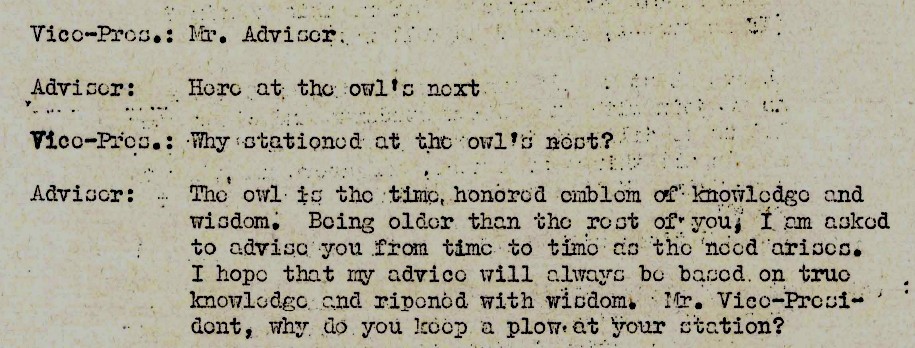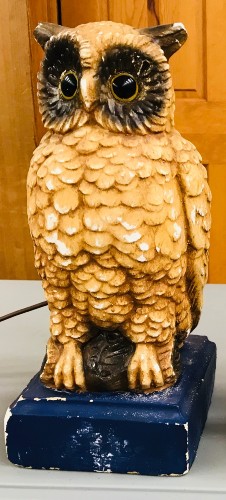The phrase “Here by the owl” is repeated thousands of times across America during the opening ceremony for an FFA meeting. As FFA advisors, we probably never give much thought to this phrase that we could mumble in our sleep. However, there is some interesting history associated with the owl as the advisor’s symbol. In this Friday Footnote, we will delve into that history.
Initially, the FFA advisor was stationed at the Owl’s Nest. The very first FFA manual (1929-30, p. 17), which was mimeographed, has the following passage:

Figure 1 – The advisor’s part in the FFA Opening Ceremony. Please note the typographical error of nest (next).
Instructions for setting up the meeting room follow on the next page of the manual (p. 18). Advisors are told to obtain a stuffed owl and place the owl on a tree limb above the station of the advisor (see below).

Figure 2: Recommendation from the 1929-30 FFA Manual
concerning the owl for the advisor.
The image below was taken at the Henry Groseclose FFA Museum in Ceres, Virginia. This stuffed owl is over the door leading to the agriculture teacher’s office from the agriculture classroom.

All of the 1930 era FFA Manuals state the advisor is stationed at the owl nests. The 1940 FFA Manual has the advisor at the owl. Apparently, this was a staff decision as there is no official record in the minutes of the FFA convention or Board of Directors to change “owl’s nest” to “owl” in the opening ceremony (at least not that I can find).
In 1931 the FFA delegates approved the establishment of collegiate FFA chapters. However, no policies or procedures were established for the collegiate chapters. At the Board of Trustees meeting in April of 1932 the following actions regarding collegiate FFA chapters were approved (FFA Board of Trustees Minutes, 1932, p. 13):
- The collegiate chapter insignia shall consist of a bronze owl or gold owl pin upon which is superimposed the insignia of the F. F. A.
- Trainees who have enrolled for agricultural education in a teacher-training institution for vocational agriculture recognized by the State and Federal Boards for Vocational Education and who have been elected by a majority vote of the membership in the local collegiate chapter are entitled to wear the bronze owl pin.
- Members doing outstanding work in agricultural education and showing marked interest in the collegiate chapter and in furthering the interest of the F. F. A. may be advanced to the collegiate Future Farmer degree by majority vote of the members of the local collegiate chapter. Those attaining the degree of Collegiate Future Farmer are entitled to wear the gold owl pin.
The images below are of the owl pins along with ordering information from the Balfour Company. The left image is the bronze pin. The right image is the gold pin.


In March of 1936 Homer Paul Anderson was called on the carpet by the FFA Board of Trustees. He was the editor of the American Farm Youth magazine (see the Friday Footnote for August 14, 2018). He was using the FFA emblem on the cover page and tacitly implied that the magazine was an official FFA magazine; which it was not. The Board was also concerned that the magazine carried advertisements for “chapter owls” from the Chapter Supply Company. The “chapter owls” are not described so it is unclear what the objection was, especially when one considers that the first FFA manual advocated stuffed owls and the Board reported in 1939 they were having difficulty in finding suitable artificial owls.
The National Audubon Society learned that the FFA advocated the use of stuffed owls in the opening ceremony and wrote a letter protesting the killing of owls to the National FFA. The FFA Board, at their March 1938 meeting, considered the letter and (p. 6) “In response to this protest the Board agreed that Mr. Ross should write this society a letter stating that the F.F.A. will instruct its members to kill no owls except the Great Horned Owl which is predatory.” There is no indication of how the National Audubon Society accepted this news.
Seven months later at the National FFA Convention (1938. p. 8) there was “…discussion about the killing of owls and the advisability of providing artificial owls for Advisers’ stations” during a committee of the whole session. As a result of the discussion the following motion was made (p. 19) “Moved by Pulliam of Nebraska, seconded and carried, that the Board of Trustees investigate further the matter of securing artificial owls for advisers’ stations and that they be given power to act as they see fit.”
At the 1939 FFA convention, the Executive Secretary reported that efforts were being made to find an artificial owl (and a rising sun) for use by FFA chapters. However, at the FFA Board of Directors meeting immediately prior to the convention (1939, p. 2) there was a very brief report that “…no satisfactory artificial owl found.” At the 1939 convention, the constitution was amended to also allow advisors to wear a special owl pin (this was in addition to collegiate FFA members).
At the National FFA Convention in 1940 a motion was made to appoint a committee “…to take up the matter of finding a suitable owl for the use of local chapters and associations at the adviser’s station…” (Proceedings, p. 17). When the Committee presented their report later in the week Bob Romack (who was now editor of the American Farm Youth and owner of the Chapter Supply Company of Danville, Illinois) furnished information about a proposed owl (Proceedings, p. 26). The committee recommended (Proceedings, p. 36) “…the national organization of F.F.A. accept the owl displayed by Chapter Supply Company of Danville, Illinois. The price of the owl is to be $3.25 f.o.b. Chicago. A lower price of $3.15 will be made on orders of ten or more by any one person.” The report was approved by the delegates.
The image below is of an owl produced by the Chapter Supply Company. The owl is on display in the historical exhibit at the North Carolina FFA Leadership Center in White Lake, NC. It was donated by the Mount Pleasant FFA chapter in North Carolina. It is made of Plaster of Paris and does have an electrical connection to a light bulb inside the owl that allows the eyes to light up. It is possible that the Chapter Supply Company made other variations of the owl.

At some point in time, Sears and Roebuck produced an owl for advisors. Two pictures are below. One shows a wooden background and once doesn’t. I don’t know if the wood background was added by a teacher or if it came that way. The engraving on the base states “Presented to Local Chapter of the FFA by Sears Roebuck and Co.”


I have searched for information about the Sears owl but have found nothing. My best guess is that it was donated to FFA chapters by Sears. We know that John Deere donated silver plows and that Swift and Company donated pictures of G. Washington, T. Jefferson, H. O. Sargent and Booker T. Washington to FFA and NFA chapters. So, it is possible that Sears did the same. Given the challenge of finding a proper owl for the FFA advisor, Sears might have attempted to solve the problem. If someone knows more about the Sears owl, please share that information with the profession.
I have found numerous references to regional agents for Sears attending agricultural teacher meetings in various states. Sears also supported a variety of livestock chains for FFA and 4-H. Sears was an avid supporter of agricultural efforts and causes, especially in the South. The one-time governor of Georgia, Eugene Talmadge, observed that “The poor dirt farmer ain’t got but three friends on this earth: God Almighty, Sears Roebuck, and Gene Talmadge.” It is plausible that Sears donated owls to FFA chapters. The engraving on the owl would indicate this is true.
I doubt if it is proper parliamentary procedure to make a motion not to do something, but such a motion was made at the national FFA convention in 1942. The 1942 Proceedings (p. 23) state “It was moved by Harris of North Carolina that the national organization should not provide pictures of the Great Horned Owl to be used at the Adviser’s station; motion seconded and carried.” It would be interesting to know what prompted this motion.
It is probable that the owl issue subsided in 1948 when the FFA Supply Service started operating. It would be logical that they would produce FFA officer stations. One concern was voiced at the July 1953 FFA Board of Directors meeting. The minute’s state (p. 8)“It was agreed that a design for the owl should be based on a picture in a bird book, and the manufactured owl should not have the eyes lighted.” This seems to be in reference to the owl carried by the FFA Supply Service as most of the items of business at this meeting were about Supply Service merchandise.
The following are various renditions of the advisors’ station owl over the years from the FFA Supply Service.

Traditionally, many Native American Tribes considered owls to be a symbol of death. However, there are some tribes who believe owls are a protective spirit and are carriers of ancient knowledge and bring wisdom to their leaders. For more information about “Owls in the Native America Culture” visit this web site at the Buffalo Bill Center for the West.
Because of the beliefs of Native Americans about owls, the FFA opening ceremony has been modified in some locations. The type and extent of the modification often depend upon the tribal leadership. One FFA chapter in Arizona skips over the owl part of the opening ceremony with the advisor starting with “Being older than the rest of you…”. I have been told that in some chapters the Eagle has been substituted for the Owl.
At the 2019 Missouri Vocational Agriculture Teachers Association summer conference these FFA officer stations were auctioned. They sold for $900. Mr. Larry Brooks, a retired agriculture teacher in Berryville, Arkansas carved them. The advisor’s owl is unique.

The owl pictured below is also unique. This owl was made by Carter Luther, Jerome, Idaho agriculture teacher. it is carved out of California Giant Redwood Bark. It was made for Marvin Jaegles, National FFA president from Idaho in 1942-43.

Concluding Remarks
I realize this is a trying time for many agriculture teachers and we face a variety of challenges. However, I hope that we remember these words from the FFA opening ceremony:
The owl is a time-honored emblem of knowledge and wisdom. Being older than the rest of you, I am asked to advise you from time to time, as the need arises. I hope that my advice will always be based on true knowledge and ripened with wisdom.
Now, more than ever, we need true knowledge ripened with wisdom.
Acknowledgments
Images and information for this Footnote were supplied by Jim Connors (University of Idaho), David Laatsch (retired ag teacher, Wisconsin), Andrew Smith (Virginia Farm Bureau), Christopher Stripling (University of Tennessee), and Troy White (South Dakota State University.
